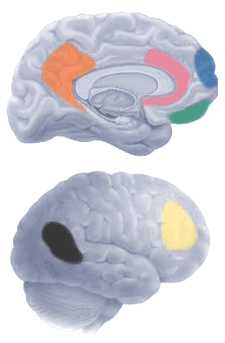 |
> MORAL MOTIVATION OR INTENT (NEUROPHYSIOLOGY AND PSYCHOLOGY)
> THE NEUROLOGICAL BASIS OF MORAL THINKING AND FEELING
 In recent years, neurological imaging techniques especially have proven useful in monitoring brain activity of subjects in the midst of moral thinking (at right, fMRI).
For example, the ventromedial prefontal cortex (below, green) shows activity when subjects view images that evoke moral impressions but do not require any actual moral judgment. This area has been proposed as part of a network involving feelings related to social interactions. People with damage to this area (such as Phineas Gage) are less able to integrate emotional information into judgments that also involve an analysis of costs and benefits, and their conclusions reflect a corresponding bias.
In recent years, neurological imaging techniques especially have proven useful in monitoring brain activity of subjects in the midst of moral thinking (at right, fMRI).
For example, the ventromedial prefontal cortex (below, green) shows activity when subjects view images that evoke moral impressions but do not require any actual moral judgment. This area has been proposed as part of a network involving feelings related to social interactions. People with damage to this area (such as Phineas Gage) are less able to integrate emotional information into judgments that also involve an analysis of costs and benefits, and their conclusions reflect a corresponding bias.
 By comparison, when moral reflection turns to interpreting and assessing other people's intentions, the key brain area seems to be the right temporoparietal junction (brown). When moral problems become personal, the medial frontal gyrus (blue) becomes more active. More abstract or hypothetical problems, by contrast, tend to activate the dorsolateral prefontal cortex (yellow) and other areas. When such different forms of thinking conflict, as one often finds in moral dilemmas, activity rises in the anterior cingulate cortex (pink) — perhaps serving a mediator role. The posterior cingulate (orange) seems involved in integrating emotions, imagery and memory, especially import to coherent narratives. Thinking in terms of a single "moral organ" thus seems inappropriate. As initially sketched by Darwin, multiple faculties seem involved, distributed throughout the brain. Indeed, all regions active in moral thinking have been implicated in other, non-moral mental processes. None seems devoted exclusively to moral thinking (Damasio et al 1994; Greene and Haidt 2002; Miller 2008).
By comparison, when moral reflection turns to interpreting and assessing other people's intentions, the key brain area seems to be the right temporoparietal junction (brown). When moral problems become personal, the medial frontal gyrus (blue) becomes more active. More abstract or hypothetical problems, by contrast, tend to activate the dorsolateral prefontal cortex (yellow) and other areas. When such different forms of thinking conflict, as one often finds in moral dilemmas, activity rises in the anterior cingulate cortex (pink) — perhaps serving a mediator role. The posterior cingulate (orange) seems involved in integrating emotions, imagery and memory, especially import to coherent narratives. Thinking in terms of a single "moral organ" thus seems inappropriate. As initially sketched by Darwin, multiple faculties seem involved, distributed throughout the brain. Indeed, all regions active in moral thinking have been implicated in other, non-moral mental processes. None seems devoted exclusively to moral thinking (Damasio et al 1994; Greene and Haidt 2002; Miller 2008).
Neuroimaging studies show significantly that actual moral reasoning involves both emotion and logic. Philosophers have long debated which is (or should be) primary in moral judgment. In practice, as least, both seem to be relevant (Greene and Haidt 2002).
|

 |